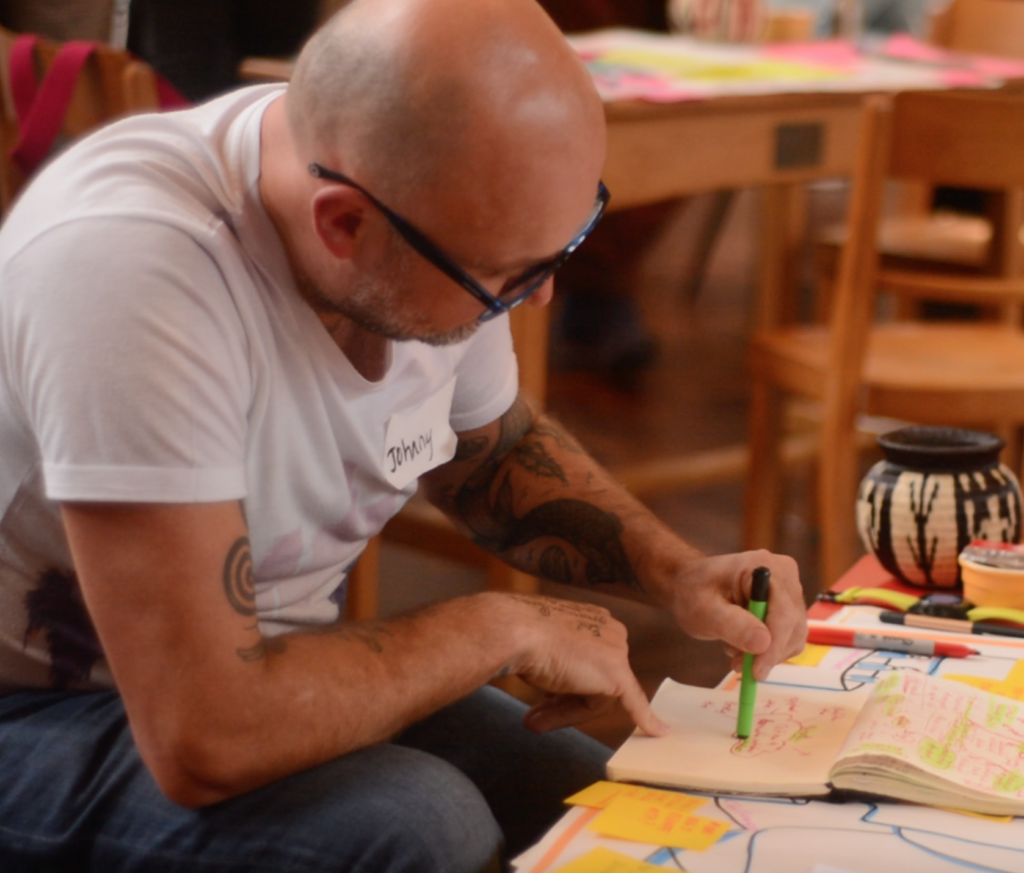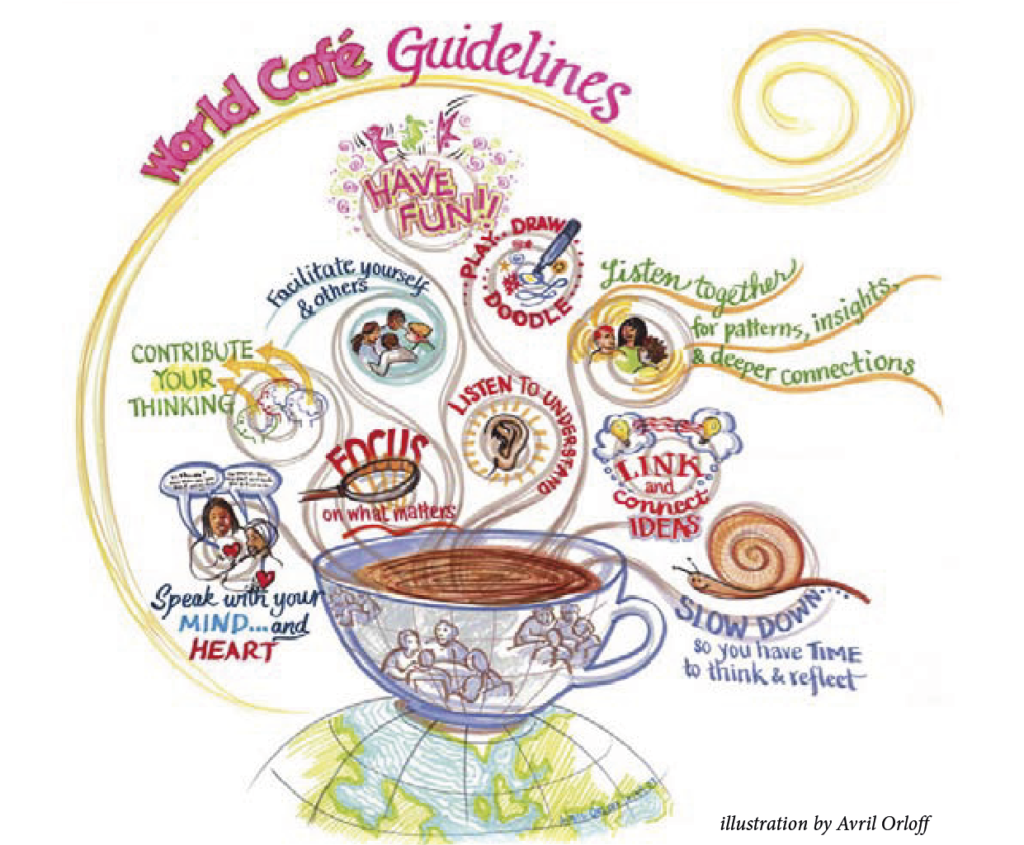World Cafe
World Cafe is a method for creating a living network of collaborative dialogue around questions that matter in service to real work. Cafés in different contexts have been named in many ways to meet specific goals, for example Diagnostic Café, Strategy Café, Consultation Café, etc. World Café conversations are based on the principles and format developed by the World Café, a global movement to support conversations that matter in corporate, government, and community settings around the world.

World Cafe is also a provocative metaphor enabling us to see new ways to make a difference in our lives and work. The power of conversation is so invisible and natural that we usually overlook it. For example, consider all the learning and action choices that occur as people move from one conversation to another inside our organizations and communities. What if we considered all of these conversations as one big dynamic Café, each a table in a larger network of living conversations which is the core process for sharing our collective knowledge and shaping our future? Once we become aware of the power of conversation as a key process in all aspects of our lives, we can use it more effectively for our mutual benefit.
What is World Cafe best used for?

- Harnessing collective intelligence and helping a group to move from individual understanding to collective understanding of an issue or matter of importance to them.
- Understanding what a group of people of any size are thinking about a particular topic and supporting them to be in charge of theming and prioritising their ideas.
- Building up a community around a topic, challenge or question
- Ganing a deeper understanding or learn about a particular issue
- Helping a group of people move from their individual experiences or stories towards a collective understanding or collective story and identifying common themes and patterns before moving to making collective sense of the conversations and information gathered.
When is World Cafe the best meeting format to use?
A world cafe works very well in many contexts such as strategic direction setting, reflecting after action, envisioning the future, consulting with stakeholders as part of a policy making process or a change management process, for morale or team building, community planning, collaboration and deep learning about issues and perspectives.

What outcomes can I expect from a World Cafe?

- People will feel actively engaged and will connect deeply through small rounds of conversations
- People will feel the final result is theirs as they will move from their individual stories in round one toward their collective story in round two whilst they identify key insights and patterns to help them finally theme and prioritise what they consider is at the core of what they have been conversing about.
- Participants will self organise to collaborate in small groups to gather and organise key information making the synthesis of the conversations easier for the convener and facilitators.
- People will leave the meeting energised, activated and likely wanting to be part of any arising emerging actions as a result of their conversations.
- If the purpose is to synthesize information gathered during the event and time for this is allowed, the final result will include priorities set as well as detailed raw information to back this up with a good trail of information.
How does a World Cafe meeting work?
Firstly a purpose for the the meeting has to be identifies, Once you know what you want to achieve and the amount of time you have to work with, you can decide the appropriate number and length of conversation rounds, the most effective use of questions and the most interesting ways to connect and cross-pollinate ideas.
The set up of the space is very important, we create a cozy environment that, where possible, resembles that of a cafe where you would informally meet friends or colleagues. We set up a couple of large paper sheets as table cloth and place some makers, pens, coloured pencils and plasticine on the table. If possible we also place some sweets and a base with flowers or a candle. We usually also have some nice music playing softly in the background to provide further ambience.
Needless to say a World Cafe does require hospitality and making sure we are providing some coffee/ drink and snacks for people throughout the activity.

- The meeting initiates by sharing the purpose and context of the meeting followed by a brief explanation of the logistics of the process and expected results before unveiling the first question. Each round has a question which is unveiled one at a time.
- Four (five max) people sit at small Café-style tables or in conversation clusters.
- They work in progressive (at least three) rounds of conversation, approximately 20- 30 minutes each.
- They engage questions or issues that genuinely matter to your life, work, or community.
- Participants are invited to write, doodle and draw key ideas on their tablecloths (and/ or note key ideas on large index cards or placemats in the center of the table).
- Upon completing the initial round of conversation, we may ask one person to remain at the table as a “table host” for the next round, while the others serve as travelers or “ambassadors of meaning.” The travelers carry key ideas, themes and questions into their new conversations, while the table host welcomes the new set of travelers.
- By providing opportunities for people to move in several rounds of conversation, ideas, questions, and themes begin to link and connect. At the end of the second or third round, all of the tables or conversation clusters in the room will be cross-pollinated with insights from prior conversations.
- In the last round of conversation, people can return to their first table to synthesize their discoveries, or they may continue traveling to new tables.
- We may use the same question for one or more rounds of conversation, or we may pose different questions in each round to build on and help deepen the exploration.
- Depending on the purpose, during the last round, people may be asked to cluster, prioritize, or otherwise identify key information to report back to the main group.
- After at least three rounds of conversation, a period of sharing discoveries & insights in a whole group conversation is initiated. It is in these town meeting-style conversations that patterns can be identified, collective knowledge grows, and possibilities for action emerge.

